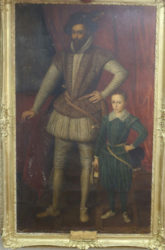Dorofield Hardy’s painting Sir Walter Raleigh and Son is the subject of this the 15th Conversation on Art between Artists Stanley Greaves AA and Akima McPherson. The oil painting, completed in 1933, forms part of the exhibition ‘From Colony to Nation’ celebrating Guyana’s 50th Independence Anniversary currently on at the National Art Gallery, Castellani House. This painting and the other works of art are available for viewing until July 30 at the gallery.
Stanley Greaves: The 50th Independence anniversary art exhibition at Castellani House is of historic importance. The first time ever we see an extended range of work in different media from the 19th century to the present displayed on all the floors. It was interesting to see watercolours produced by British artists who were military personnel, given the job to record the landscape in which they were on duty. Topographical sketches where today cameras do the job. The “Queen’s Collection” has the life size portrait of Sir Walter Raleigh and his son. Raleigh wrote The Discoverie of Guyana describing the region in which he hoped to find the legendary City of El Dorado. He never did but lost his head instead in the Tower of London.
Akima McPherson: The exhibition From Colony to Nation (at Castellani House) is an interesting one. While several of the pieces on view are familiar from the National Collection, several are less familiar as they are from the

Guyana National Museum, University of Guyana, and St Joseph Mercy Hospital collections. The “Queen’s Collection” from the National Museum offers royal portraiture in scale, style and competency of established 18th century European traditions. The images bear no visible connection to Guyana and recalls for me that portion of the unofficial art historical narrative which speaks of art made in the colony being made for European expatriates nostalgic for home. Of the 175 pieces on view, I was most excited by the Amedee Forestier lithographs (in catalogue as Amedec Forrestier) from the University of Guyana Collection. These are a trio of scenes from Georgetown in the late 19th century. One can see within them different strata of British Guiana socio-cultural and socio-economic society in what seems to be comfortable co-existence with each other. The landscape within the images are familiar and gives one a sense of what was in relation to what is today. They offer interesting points of contrast and bring the past deliciously alive for me.
S.G: Having read in art history books about official portraits it was interesting to see those of the Royal Family in the “Queen’s Collection” from the National Museum. These were actually propaganda works produced and sent to Common-wealth countries so we knew who our rulers were. I found the Sir Walter Raleigh and Son very interesting because of a particular artistic convention used. The figure of Raleigh is exaggerated in height to give a sense of importance. We can find examples from early pictures of mankind from prehistoric times and this continues to now especially in statues. It is fascinating to see this in the presentation of ancient Egyptian pharaohs, and sculptures of West African rulers. Ice-Stall in the Market, Georgetown (1888) was particularly appealing because the scene could have been taken from any busy day today. Each figure in the scene was a clearly defined accurate portrait in miniature, a good example of observation and draughtsmanship. The ice was harvested from lakes in the USA and shipped to British Guiana in huge blocks covered with sawdust.
A.M: Your last historical mention in relation to one of the Forestier lithographs underscores the use of ice in everyday cooling. As Guyanese, we generally understand the function of the Demerara windows in pre-electrical air-conditioning – quite ingenious. And with the remnants of the Ice Factory on Water Street I had not for a second considered the ice was not made locally, but was imported. This, therefore, makes logical the association I have from literary and first person accounts of ice as a privilege in upper and middle class home cooling. So the people in Ice-Stall in the Market, Georgetown are likely workers of the wealthy.









